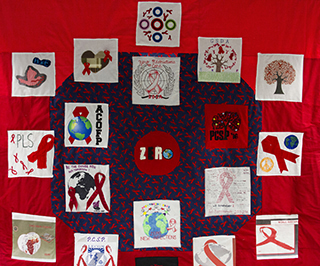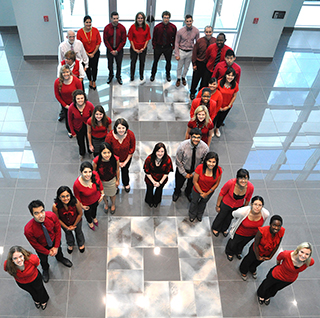The Lake Erie College of Osteopathic Medicine (LECOM) took time to remember the millions of people, both past and present, affected by HIV/AIDS during recent World AIDS Day observances.
Students, faculty and staff at LECOM’s campuses in Erie and in Bradenton, Fla., gathered for “Human Red Ribbon” photos. A red ribbon is intended to symbolize many voices, united, seeking a meaningful response to HIV/AIDS. The ribbon also serves as a symbol of hope and as a reminder of the many people suffering with the disease and of those working toward a cure.
In addition, students, faculty and staff in Erie watched a short video on HIV/AIDS and hung ribbons on a Tree of Remembrance and Hope. Christine Kell, Ph.D., Associate Dean of Preclinical Education and Professor of Microbiology, and students, faculty and staff created a memorial quilt that was displayed along with quilts from LECOM’s prior AIDS Day observances.
 |
| Quilt made by LECOM students, faculty and staff.. |
The importance of observing World AIDS Day, and of raising awareness of the disease, wasn’t lost on student participants such as Seth Carter, OMS1, and Jaxson Burkins, P1.
“World AIDS Day, for me, is about taking a stand to help lessen the pain and suffering caused by HIV – and not just the physical pain,” Carter said. “People often struggle emotionally and socially because the disease still isn’t universally understood. It’s important for those with HIV/AIDS to know that there is a support system for them.”
Said Burkins, “It seems like in recent years, societal awareness has shifted away from HIV and AIDS and more toward diseases like cancer, especially in the United States. Events like World AIDS Day are important to make sure we never lose sight of the fact that AIDS is still very prevalent and is still a deadly disease if left untreated.”
Indeed, in recent years, AIDS has become somewhat of an afterthought, at least in terms of how frequently and how prominently the disease and its victims are mentioned in print and on television newscasts. Since media coverage of HIV/AIDS peaked in the late 1980s, it has steadily declined, leading to terms such as “AIDS fatigue.”
And yet, despite advancements in treatments, HIV/AIDS remains a vitally important public health concern. According to the Centers for Disease Control and Prevention, more than 1.1 million people in the United States have HIV, and in 2011 nearly 50,000 Americans were diagnosed with it. In 2012, AIDS-related deaths numbered 1.7 million globally; the World Health Organization estimates that about 35 million people worldwide have died since the beginning of the epidemic.
Those types of numbers are why Richard Ortoski, D.O., Regional Dean, Professor and Chair of Primary Care Education, and Co-Director of the Primary Care Scholars Pathway at the Lake Erie College of Osteopathic Medicine (LECOM), annually organizes a campus observance.
 |
| Human red ribbon at LECOM’s campus in Bradenton, Fla. |
Dr. Ortoski also serves as Medical Director for the Northwest Pennsylvania Rural Aids Alliance, which has eight clinics, including one in Erie. “HIV/AIDS isn’t in the forefront societally like it used to be,” he said. “HIV patients who can afford the treatments and tolerate the side effects of the treatments are living longer. An HIV diagnosis isn’t a death sentence, but it is still a dangerous disease if you don’t seek treatment.”
Dr. Ortoski thinks it’s particularly important for LECOM’s future osteopathic physicians and pharmacists to understand and appreciate the significance of World AIDS Day. “Compassionate, whole-person care is so important, because it’s inevitable that these students will treat an HIV patient,” he explained.
More about World AIDS Day
Anthony S. Fauci, M.D., Director of the National Institute of Allergy and Infectious Diseases, has said that “AIDS fatigue” has become more common in part because the number of AIDS patients in hospice care and in inner-city hospitals has declined considerably. However, the “grim reality” is that there are “far too many” AIDS-related deaths, according to a statement from the National Institutes of Health, co-authored by Dr. Fauci.
“In the 25 years that have passed since the first annual commemoration of World AIDS Day, extraordinary scientific progress has been made in the fight against HIV/AIDS,” the statement reads. “That progress has turned an HIV diagnosis from an almost-certain death sentence to what is now for many, a manageable medical condition and nearly normal lifespan. We have come far, yet not far enough. On World AIDS Day, the National Institutes of Health (NIH) reaffirms its commitment to finding improved HIV treatments and tools for preventing infection (including a vaccine), addressing the conditions and diseases associated with long-term HIV infection, and, ultimately, finding a cure.”

